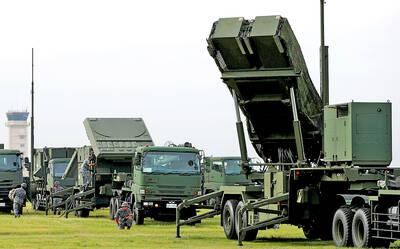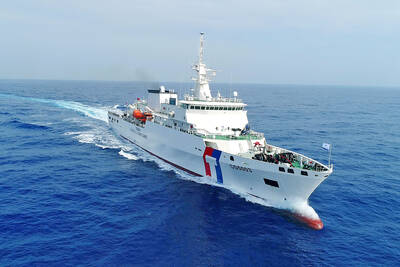The IMF on Monday proposed the sale of 403.3 tonnes of gold to bolster its sagging coffers as part of a critical financial overhaul.
The sale, amounting to some 12 percent of its gold reserves, could yield around US$11 billion, IMF officials said, supporting a reorganization of the institution as it seeks to survive a downturn in lending to troubled countries, its main income source.
Managing Director Dominique Strauss-Kahn said in a statement that the IMF would use the funds to help shore up IMF finances and create a new endowment with more diverse investments to generate income.
The announcement comes with the IMF in the midst of an intense effort to trim costs and slash jobs as its lending is scaled back, with some countries refusing the IMF’s conditional aid.
The IMF faces a budget shortfall of some US$140 million for the fiscal year 2008 that ends on April 30.
The IMF’s has 2,931 tonnes of gold reserves.
IMF officials said the sale would likely take place over several years in an effort to avoid market disruption.
Still, the sale could have a dramatic impact on the market, where IMF officials said some 500 tonnes are traded annually.
Gold prices recently hit an all-time record above US$1,000 an ounce.
An IMF official speaking on condition of anonymity said an average price of about US$850 an ounce would generate about US$11 billion.
Of that, some US$6.6 billion would be used to create the endowment, he said.
The IMF said the executive board agreed to revamp the institution’s income model from one that primarily relies on lending to one that “generates funds from various sources.”
The expansion of the fund’s investment authority is contingent on a charter amendment that would need legislative action in most member countries.
In addition, approval by the US Congress is required for the US executive director to vote for the gold sale.
The reform plan requires approval by 85 percent of the voting power of the institution’s 185 member nations, which is dominated by the US.
Strauss-Kahn hailed the executive board’s proposal for a new financial framework, calling it “a landmark agreement that will put the institution on solid financial footing and modernize the IMF’s structure and operations.”
“We have made difficult, but necessary choices to close the projected income shortfall and put the fund’s finances on a sustainable basis,” Strauss-Kahn said.
The investment policies would include safeguards to ensure that the broadened investment authority “does not give rise even to perceived conflicts of interest,” the fund said.
At the same time, the board considered the medium-term budget for the financial years 2009 to 2011, which includes “deep spending cuts” of US$100 million and approved the administrative budget for the next financial year that begins on May 1.
“With these measures the fund expects to close the projected income-expenditure gap of US$400 million within a few years,” said the multilateral institution, which was created in the aftermath of World War II with a mission to promote global financial stability.
If approved, the new income model “could generate an additional US$300 million” in income within a few years, the IMF said.
Nearly 400 jobs are targeted for elimination, officials said. That process, currently under way, includes a period of voluntary departures that ends on April 21.
The announcement came ahead of the spring meetings of the IMF and its sister institution, the World Bank, in Washington this weekend.

MILITARY BOOST: The procurement was planned after Washington recommended that Taiwan increase its stock of air defense missiles, a defense official said yesterday Taiwan is planning to order an additional four PAC-3 MSE systems and up to 500 missiles in response to an increasing number of missile sites on China’s east coast, a defense official said yesterday. The official, who spoke on condition of anonymity, said that the proposed order would be placed using the defense procurement special budget, adding that about NT$1 trillion (US$32,88 billion) has been allocated for the budget. The proposed acquisition would include launchers, missiles, and a lower tier air and missile defense radar system, they said The procurement was planned after the US military recommended that Taiwan increase

POLITICAL AGENDA: Beijing’s cross-strait Mid-Autumn Festival events are part of a ‘cultural united front’ aimed at promoting unification with Taiwan, academics said Local authorities in China have been inviting Taiwanese to participate in cross-strait Mid-Autumn Festival celebrations centered around ideals of “family and nation,” a move Taiwanese academics said politicizes the holiday to promote the idea of “one family” across the Taiwan Strait. Sources said that China’s Fujian Provincial Government is organizing about 20 cross-strait-themed events in cities including Quanzhou, Nanping, Sanming and Zhangzhou. In Zhangzhou, a festival scheduled for Wednesday is to showcase Minnan-language songs and budaixi (布袋戲) glove puppetry to highlight cultural similarities between Taiwan and the region. Elsewhere, Jiangsu Province is hosting more than 10 similar celebrations in Taizhou, Changzhou, Suzhou,

TWO HEAVYWEIGHTS: Trump and Xi respect each other, are in a unique position to do something great, and they want to do that together, the US envoy to China said The administration of US President Donald Trump has told Chinese President Xi Jinping (習近平) “we don’t want any coercion, but we want [the Taiwan dispute] resolved peacefully,” US ambassador to China David Perdue said in a TV interview on Thursday. Trump “has said very clearly, we are not changing the ‘one China’ policy, we are going to adhere to the Taiwan Relations Act, the three communiques and the ‘six assurances’ that were done under [former US president Ronald] Reagan,” Perdue told Joe Kernen, cohost of CNBC’s Squawk Box. The act, the Three Joint Communiques and the “six assurances” are guidelines for Washington

DEEPENING TIES: The two are boosting cooperation in response to China’s coercive actions and have signed MOUs on search-and-rescue and anti-smuggling efforts Taiwan and Japan are moving to normalize joint coast guard training and considering the inclusion of other allies, the Japanese Yomiuri Shimbun reported yesterday. Both nations’ coast guards in June sent vessels to the seas south of the Sakishima Islands to conduct joint training, the report said, adding that it was the second joint maritime training exercise since the nations severed formal diplomatic ties in September 1972. Japan dispatched the Nagoya Coast Guard’s Mizuho, a 134m, 6,000-tonne patrol vessel which can carry a helicopter, while the Coast Guard Administration (CGA) sent the 126m, 4,000-tonne Yunlin, one of its largest vessels, the report